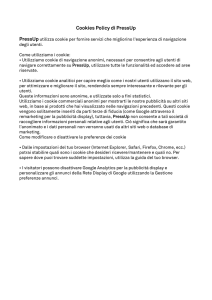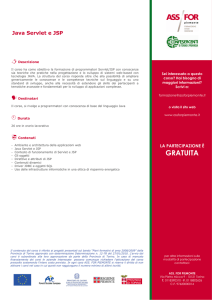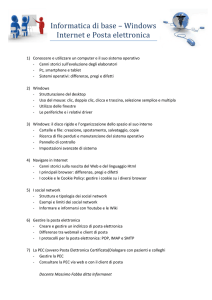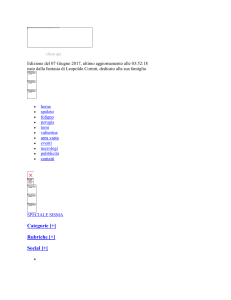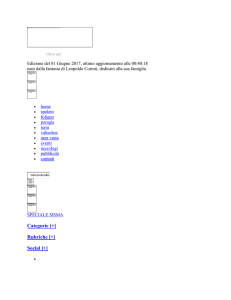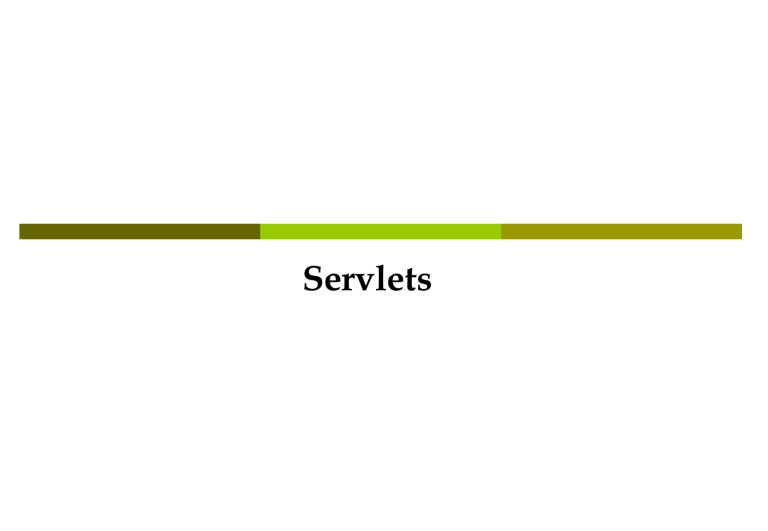
Servlets
Applets
Special Java programs (without a “main”) callable
from HTML and executed in a graphic context.
They can be executed by:
a Java enabled Web Browser;
ad-hoc programs (e.g. Sun AppletViewer).
Applets
Every applet is implemented by creating a
subclass of the Applet class.
The hierarchy determines much of what an
applet can do and how.
Applet Lifecycle
An applet can react to major events in the following
ways:
It can initialize itself.
init()
It can start running.
start()
It can draw some graphics. paint()
It can respond to user-generated events (Mouse,
keyboard, menus…). handleEvent()
It can stop running.
stop()
It can perform a final cleanup, in preparation for
being unloaded.
destroy()
Applet Lifecycle
init()
Multithreading!
start()
handleEvent()
stop()
destroy()
Whenever it’s needed,
at lower priority
paint()
Actually, more threads are active
behind the scenes.
handleEvent()
This code is part of the AWT (1.0 Event Model)
public boolean handleEvent(Event evt) {
switch (evt.id) {
case Event.MOUSE_ENTER: return mouseEnter(evt, evt.x, evt.y);
case Event.MOUSE_EXIT:
return mouseExit(evt, evt.x, evt.y);
case Event.MOUSE_MOVE: return mouseMove(evt, evt.x, evt.y);
case Event.MOUSE_DOWN: return mouseDown(evt, evt.x, evt.y);
case Event.MOUSE_DRAG: return mouseDrag(evt, evt.x, evt.y);
case Event.MOUSE_UP:
return mouseUp(evt, evt.x, evt.y);
handleEvent()
case
case
case
case
Event.KEY_PRESS:
Event.KEY_ACTION:
return keyDown(evt, evt.key);
Event.KEY_RELEASE:
Event.KEY_ACTION_RELEASE: return keyUp(evt, evt.key);
case Event.ACTION_EVENT:
case Event.GOT_FOCUS:
return action(evt, evt.arg);
return gotFocus(evt, evt.arg);
case Event.LOST_FOCUS:
return lostFocus(evt, evt.arg);
}
return false;
}
Applets-Event handling
To react to an event, an applet must override either the
appropriate event-specific method or the
handleEvent method.
For example, adding the following code to the Simple
applet makes it respond to mouse clicks.
import java.awt.Event;
...
public boolean mouseDown(Event event, int x, int y) { addItem("click!... ");
return true;
}
Servlets (JDK 1.2)
Servlets are modules that extend Java-enabled web servers. For example, a
servlet might be responsible for taking data in an HTML order-entry form
and applying the business logic used to update a company's order
database.
Servlets are to servers what applets are to browsers. Unlike
applets, however, servlets have no graphical user interface.
For a full tutorial, see
http://java.sun.com/docs/books/tutorial/servlets/overview/index.html
Other uses of servlets
Allowing collaboration between people.
A servlet can handle multiple requests concurrently, and can synchronize
requests. This allows servlets to support systems such as on-line
conferencing.
Forwarding requests.
Servlets can forward requests to other servers and servlets. Thus servlets
can be used to balance load among several servers that mirror the same
content, and to partition a single logical service over several servers,
according to task type or organizational boundaries.
Applets vs. Servlets
Applet
Servlet
Gira:
Client
Server
Ha un main:
NO
NO
Estende:
java.applet.Applet
javax.servlet.http.
HttpServlet
Grafica
SI
NO
Cuore:
handleEvent()
service()
Servlet Lifecycle
Chiamato solo la prima volta che la
Servlet viene caricato in memoria!
init()
doXXX()
service(HttpServletRequest r,
HttpServletResponse p)
doGet()
doPost()
Se la Servlet implements SingleThreadModel non
ci saranno esecuzioni simultanee di codice
destroy()
Solo quando serve scaricare dalla
memoria!
service()
This code is part of the class HttpServlet
protected void service (HttpServletRequest req, HttpServletResponse resp)
throws ServletException, IOException
{
String method = req.getMethod ();
if (method.equals ("GET")) {
long
ifModifiedSince; long
lastModified; long
now;
ifModifiedSince = req.getDateHeader ("If-Modified-Since");
lastModified = getLastModified (req);
maybeSetLastModified (resp, lastModified);
if (ifModifiedSince == -1 || lastModified == -1)
doGet (req, resp);
else {
now = System.currentTimeMillis ();
if (now < ifModifiedSince || ifModifiedSince < lastModified)
doGet (req, resp);
else
resp.sendError (HttpServletResponse.SC_NOT_MODIFIED);
}
service()
} else if (method.equals ("HEAD")) {
long
lastModified;
lastModified = getLastModified (req);
maybeSetLastModified (resp, lastModified);
doHead (req, resp);
} else if (method.equals ("POST")) {
doPost (req, resp);
} else if (method.equals ("PUT")) {
doPut(req, resp);
} else if (method.equals ("DELETE")) {
doDelete(req, resp);
} else if (method.equals ("OPTIONS")) {
doOptions(req,resp);
} else if (method.equals ("TRACE")) {
doTrace(req,resp);
} else {
resp.sendError (HttpServletResponse.SC_NOT_IMPLEMENTED,
"Method '" + method + "' is not defined in RFC 2068");
}
}
A taste of servlet programming-1
public class SimpleServlet extends HttpServlet {
/** Handle the HTTP GET method by building a simple web page.
*/
public void doGet (HttpServletRequest request,
HttpServletResponse response)
throws
ServletException, IOException {
PrintWriter out;
String title = "Simple Servlet Output";
A taste of servlet programming-2
// set content type and other response header fields first
response.setContentType("text/html");
// then write the data of the response
out = response.getWriter();
out.println("<HTML><HEAD><TITLE>");
out.println(title);
out.println("</TITLE></HEAD><BODY>");
out.println("<H1>" + title + "</H1>");
out.println("<P>This is output from
SimpleServlet.");
out.println("</BODY></HTML>");
out.close();
}
}
Esempio: ShowParameters
package coreservlets;
import java.io.*;
import javax.servlet.*;
import javax.servlet.http.*;
import java.util.*;
public class ShowParameters extends HttpServlet {
public void doGet(HttpServletRequest request HttpServletResponse
response)
throws ServletException, IOException {
response.setContentType("text/html");
PrintWriter out = response.getWriter();
String title = "Reading All Request Parameters";
out.println ("<HTML><HEAD><TITLE>" +title+ “</TITLE></HEAD>"
+
"<BODY BGCOLOR=\"#FDF5E6\">\n" +
"<H1 ALIGN=CENTER>" + title + "</H1>\n" +
"<TABLE BORDER=1 ALIGN=CENTER>\n" +
"<TR BGCOLOR=\"#FFAD00\">\n" +
"<TH>Parameter Name<TH>Parameter Value(s)");
Esempio: ShowParameters
Enumeration paramNames = request.getParameterNames();
while(paramNames.hasMoreElements()) {
String paramName = (String)paramNames.nextElement();
out.print("<TR><TD>" + paramName + "\n<TD>");
String[] paramValues = request.getParameterValues(paramName);
if (paramValues.length == 1) {
String paramValue = paramValues[0];
if (paramValue.length() == 0) out.println("<I>No Value</I>");
else out.println(paramValue);
} else {
out.println("<UL>");
for(int i=0; i<paramValues.length; i++) {out.println("<LI>"
+paramValues[i]); }
out.println("</UL>");
}
}
out.println("</TABLE>\n</BODY></HTML>");
}
Esempio: ShowParameters
public void doPost(HttpServletRequest request,
HttpServletResponse response)
throws ServletException, IOException {
doGet(request, response);
}
}
Esempio: ShowParameters
<!DOCTYPE HTML PUBLIC "-//W3C//DTD HTML 4.0 Transitional//EN">
<HTML>
<HEAD>
<TITLE>A Sample FORM using POST </TITLE>
</HEAD>
<BODY BGCOLOR="#FDF5E6">
<H1 ALIGN="CENTER">A Sample FORM using POST</H1>
<FORM ACTION="/servlet/coreservlets.ShowParameters“
METHOD="POST”>
Item Number: <INPUT TYPE="TEXT" NAME="itemNum"><BR>
Quantity: <INPUT TYPE="TEXT" NAME="quantity"><BR>
Price Each: <INPUT TYPE="TEXT" NAME="price" VALUE="$"><BR>
<HR>
First Name: <INPUT TYPE="TEXT" NAME="firstName"><BR>
Last Name: <INPUT TYPE="TEXT" NAME="lastName"><BR>
Middle Initial: <INPUT TYPE="TEXT" NAME="initial"><BR>
Shipping Address:
<TEXTAREA NAME="address" ROWS=3 COLS=40></TEXTAREA><BR>
Esempio: ShowParameters
Credit Card:<BR>
&nbsp;&nbsp;<INPUT TYPE="RADIO" NAME="cardType“
VALUE="Visa">Visa<BR>
&nbsp;&nbsp;<INPUT TYPE="RADIO" NAME="cardType"
VALUE="Master Card">Master Card<BR>
&nbsp;&nbsp;<INPUT TYPE="RADIO" NAME="cardType"
VALUE="Amex">American Express<BR>
&nbsp;&nbsp;<INPUT TYPE="RADIO" NAME="cardType“
VALUE="Discover">Discover<BR>
&nbsp;&nbsp;<INPUT TYPE="RADIO" NAME="cardType"
VALUE="Java SmartCard">Java SmartCard<BR>
Credit Card Number:
<INPUT TYPE="PASSWORD" NAME="cardNum"><BR>
Repeat Credit Card Number:
<INPUT TYPE="PASSWORD" NAME="cardNum"><BR><BR>
<CENTER><INPUT TYPE="SUBMIT" VALUE="Submit
Order"></CENTER>
</FORM>
</BODY>
</HTML>
Cookies
Cookies: perché?
Identificazione di un utente in una sessione di ecommerce.
Customizzazione di un sito
Pubblicità mirata
Eliminazione di username e password
Cookies: i metodi
public void setComment(String c)
public String getComment()
public void setVersion(int c)
public int getVersion ()
Version 0: Netscape standard
Version 1: RFC 2109
Cookies: i metodi
public void setMaxAge(int c)
public int getMaxAge()
Positive value: secondi di vita
0: delete cookie
Negative value: finchè dura la sessione del browser
Cookies: i metodi
public void setDomain(String c)
public String getDomain()
public void setPath(int c)
public int getPath()
Cookies: esempio
Cookie userCookie = new Cookie(“user”,”uid1234”);
userCookie.setMaxAge(60*60*24*365);
response.addCookie(userCookie);
SetCookies
import java.io.*; import javax.servlet.*; import javax.servlet.http.*;
/** Sets six cookies: three that apply only to the current session
* (regardless of how long that session lasts) and three that persist for an hour
* (regardless of whether the browser is restarted).
*/
public class SetCookies extends HttpServlet {
public void doGet(HttpServletRequest request, HttpServletResponse response)
throws ServletException, IOException {
for(int i=0; i<3; i++) {
// Default maxAge is -1, indicating cookie
// applies only to current browsing session.
Cookie cookie = new Cookie("Session-Cookie-" + i,
"Cookie-Value-S" + i);
response.addCookie(cookie);
SetCookies
cookie = new Cookie("Persistent-Cookie-" + i,"Cookie-Value-P" + i);
// Cookie is valid for an hour, regardless of whether
// user quits browser, reboots computer, or whatever.
cookie.setMaxAge(3600);
response.addCookie(cookie);
}
response.setContentType("text/html");
PrintWriter out = response.getWriter();
String title = "Setting Cookies";
out.println (("<HTML><HEAD><TITLE>" +title+ “</TITLE></HEAD>" +
"<BODY BGCOLOR=\"#FDF5E6\">\n" +"<H1 ALIGN=\"CENTER\">"
+ title + "</H1>\n" +"There are six cookies associated with this page.\n" +
"</BODY></HTML>");
}
}
ShowCookies
import java.io.*; import javax.servlet.*; import javax.servlet.http.*;
/** Creates a table of the cookies associated with the current page. */
public class ShowCookies extends HttpServlet {
public void doGet(HttpServletRequest request, HttpServletResponse response)
throws ServletException, IOException {
response.setContentType("text/html");
PrintWriter out = response.getWriter();
String title = "Active Cookies";
out.println(("<HTML><HEAD><TITLE>" +title+ “</TITLE></HEAD>" +
"<BODY BGCOLOR=\"#FDF5E6\">\n" +
"<H1 ALIGN=\"CENTER\">" + title + "</H1>\n" +
"<TABLE BORDER=1 ALIGN=\"CENTER\">\n" +
"<TR BGCOLOR=\"#FFAD00\">\n" +
" <TH>Cookie Name\n" + " <TH>Cookie Value");
ShowCookies
Cookie[] cookies = request.getCookies();
Cookie cookie;
for(int i=0; i<cookies.length; i++) {
cookie = cookies[i];
out.println("<TR>\n" +
" <TD>" + cookie.getName() + "\n" +
" <TD>" + cookie.getValue());
}
out.println("</TABLE></BODY></HTML>");
}
}
Sessions
Session tracking using cookies
String sessionID = makeUniqueString();
Hashtable sessionInfo = new Hashtable();
Hashtable globalTable = getTableStoringSession();
globalTable.put(sessionID,sessionInfo);
Cookie sessionCookie=new Cookie(“SessionID”,sessionID);
sessionCookie.setPath(“/”);
response.addCookie(sessionCookie);
Session tracking API
HttpSession session = request.getSession(true);
ShoppingCart cart = (ShoppingCart)session.getValue(“carrello”);
// 2.1
// 2.2 (ShoppingCart)session.getAttribute(“carrello”);
if (cart==null) {
cart=new ShoppingCart();
session.putValue(“carrello”,cart); //2.1
//2.2 session.putValue(“carrello”,cart);
}
doSomeThingWith(cart);
Session tracking API
public void removeValue(String name); //2.1
public void removeAttribute(String name);
public String[] getValueNames()
//2.1
public Enumeration getAttributeNames() //2.2
//2.2
Session tracking API
public long getCreationTime();
public long getLastAccessdTime();
Secondi dal 1.1.1970, mezzanotte
public void removeAttribute(String name);
public int getMaxInactiveInterval();
public void setMaxInactiveInterval(int sec);
public void invalidate();
ShowSession
import java.io.*; import javax.servlet.*; import javax.servlet.http.*;
import java.net.*; import java.util.*;
/** Simple example of session tracking. */
public class ShowSession extends HttpServlet {
public void doGet(HttpServletRequest request, HttpServletResponse response)
throws ServletException, IOException {
response.setContentType("text/html");
PrintWriter out = response.getWriter();
String title = "Session Tracking Example";
HttpSession session = request.getSession(true);
String heading;
// Use getAttribute instead of getValue in version 2.2.
Integer accessCount = (Integer)session.getValue("accessCount");
ShowSession
if (accessCount == null) {
accessCount = new Integer(0);
heading = "Welcome Newcomer";
} else {
heading = "Welcome Back";
accessCount = new Integer(accessCount.intValue() + 1);
}
// Use setAttribute instead of putValue in version 2.2.
session.putValue("accessCount", accessCount);
ShowSession
out.println(("<HTML><HEAD><TITLE>" +title+ “</TITLE></HEAD>" +
"<BODY BGCOLOR=\"#FDF5E6\">\n" +
"<H1 ALIGN=\"CENTER\">" + heading + "</H1>\n" +
"<H2>Information on Your Session:</H2>\n" +
"<TABLE BORDER=1 ALIGN=\"CENTER\">\n" +
"<TR BGCOLOR=\"#FFAD00\">\n" +
" <TH>Info Type<TH>Value\n" +
"<TR>\n" +" <TD>ID\n" +" <TD>" + session.getId() + "\n" +
"<TR>\n" +" <TD>Creation Time\n" +
" <TD>" + new Date(session.getCreationTime()) + "\n" +
"<TR>\n" +" <TD>Time of Last Access\n" +
" <TD>" +new Date(session.getLastAccessedTime()) + "\n" +
"<TR>\n" +" <TD>Number of Previous Accesses\n" +" <TD>" +
accessCount + "\n" + "</TABLE>\n" +"</BODY></HTML>");
}
ShowSession
/** Handle GET and POST requests identically. */
public void doPost(HttpServletRequest request,
HttpServletResponse response)
throws ServletException, IOException {
doGet(request, response);
}
}
WebApps
(Tomcat configuration)
Static pages
To let Tomcat serve static pages, we must define a “Web
Application”.
That is, in the Tomcat Document Root (by default
$CATALINA_HOME/webapps/) we must create a folder named
after our Web Application (e.g. myApp).
In that “myApp” folder, we MUST create a WEB-INF folder
(that can be empy).
webapps
In the myApp folder we can then depost the static html files.
On our Tomcat server, the URL for the hello.html file becomes:
http://machine/port/myApp/hello.html
To actually see the webapp, we must then restart Tomcat
myApp
WEB-INF
hello.html
JSP pages
To let Tomcat serve JSP pages, we follow the same
procedure that we described for static pages.
In the myApp folder we can depost the JSP files.
On our Tomcat server, the URL for the hello.jsp file becomes:
http://machine/port/myApp/hello.jsp
webapps
The WEB-INF directory is still empty.
To actually see the webapp, we must then restart Tomcat
myApp
WEB-INF
hello.jsp
Servlets
To let Tomcat serve servlet, we need add some info. The compiled
servlets (.class) must be stored in a “classes” directory in WEB-INF.
Moreover, the web.xml file MUST contain at least:
<?xml version="1.0" encoding="ISO-8859-1"?>
<!DOCTYPE web-app
PUBLIC "-//Sun Microsystems, Inc.//DTD Web Application 2.3//EN"
"http://java.sun.com/dtd/web-app_2_3.dtd">
<web-app>
<servlet-mapping>
<servlet-name>invoker</servlet-name>
<url-pattern>/magic/*</url-pattern>
</servlet-mapping>
</web-app>
The “magic” word is the servlet activation keyword (you can of course
customize this word). To execute the servlet called MyServlet.class,
the URL will be:
http://machine/port/myApp/magic/MyServlet
Servlets
The web.xml file CAN contain many additional info.
For instance, it can contain a section defining an alias
name for the servlet:
…
<servlet>
<servlet-name>pippo</servlet-name>
<servlet-class>Servlet1</servlet-class>
</servlet>
…
In such case, the servlet called MyServlet.class
Can be activated ALSO by the URL:
http://machine/port/myApp/magic/pippo
webapps
myApp
WEB-INF
web.xml
classes
MyServlet.class




